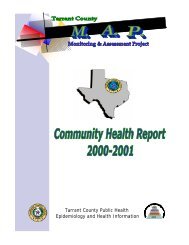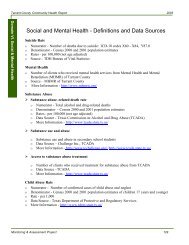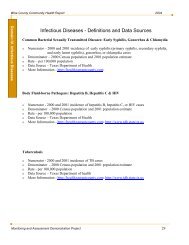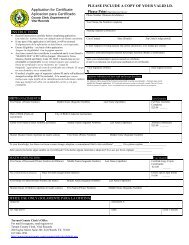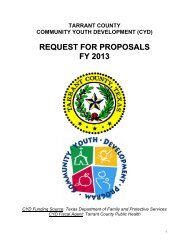MAPP Handbook - The National Association of County and City ...
MAPP Handbook - The National Association of County and City ...
MAPP Handbook - The National Association of County and City ...
You also want an ePaper? Increase the reach of your titles
YUMPU automatically turns print PDFs into web optimized ePapers that Google loves.
Other Data Considerations<br />
<strong>The</strong> following tips may be useful to small or rural communities that do not have access<br />
to epidemiological expertise in data analysis.<br />
Data should be considered in light <strong>of</strong> the following questions: What are the sources <strong>of</strong><br />
these data? Are the sources reliable? What are the issues raised by the data? Are key<br />
pieces <strong>of</strong> information missing <strong>and</strong> can they be obtained? Are there any other<br />
considerations regarding the health issue that need to be taken into account when<br />
analyzing the data? Can a summary statement be made about the numbers?<br />
Consider the following issues:<br />
• <strong>The</strong> manner in which data are collected is very important. In analyzing<br />
communicable disease information, consider the reporting system that exists in<br />
the state or locality <strong>and</strong> the kind <strong>of</strong> data that would be produced.<br />
• Consider the sampling frame used in gathering the data to ensure that all special<br />
high-risk populations are included. For example, university populations should be<br />
included when looking at youth issues, while nursing home or retirement<br />
communities should be included to get a valid rate for aging issues.<br />
• Consider time-related issues, such as the amount <strong>of</strong> time it may take for a<br />
program intervention to show results, when looking at certain health issues or<br />
diseases. For example, a decrease in cancer rates may be indicative <strong>of</strong> the<br />
success <strong>of</strong> program interventions that took place many years earlier.<br />
• Years <strong>of</strong> Potential Life Lost (YPLL) is an indicator that can provide additional<br />
information about the important causes <strong>of</strong> premature death in a community.<br />
For example, consider the number <strong>of</strong> deaths due to injuries in a community.<br />
Although the actual number <strong>of</strong> deaths due to injuries might be low, the impact<br />
<strong>of</strong> this problem could be highlighted if the YPLL is high (indicating that deaths<br />
due to injuries cause a disproportionate loss <strong>of</strong> potential productivity in<br />
younger populations).<br />
• Consider that a substantial change in a single indicator (e.g., number <strong>of</strong> cancer<br />
deaths increasing from 20 to 30 over one year) may not necessarily represent a<br />
trend or pattern. While troubling to the community, this may be a normal<br />
variation in reporting. Situations like this may present an opportunity to engage<br />
the community in the science <strong>of</strong> epidemiology. Exploring risk factors may<br />
increase the participants’ appreciation for health planning, health assessments, <strong>and</strong><br />
related activities.<br />
64




